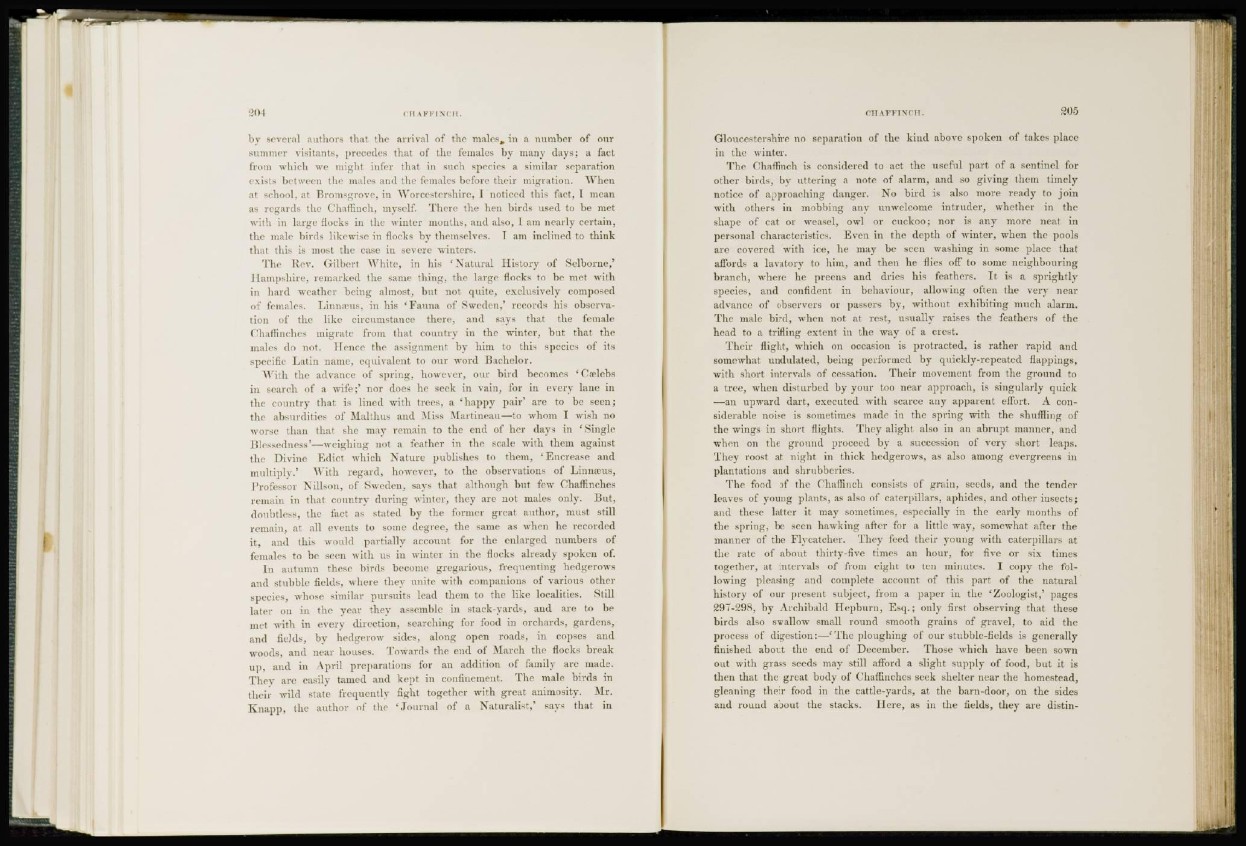
by several authors that the arrival of the malesm in a number of our
summer visitants, precedes that of the females by many days; a fact
from which we might infer that in such species a similar separation
exists between the males and the females before their migration. When
at school, at Bromsgrove, in Worcestershire, 1 noticed this fact, I mean
as regards the Chaffinch, myself. There the lien birds used to be met
-with in large Hocks in the winter months, and also, I am nearly certain,
the male birds likewise in flocks by themselves. I am inclined to think
that this is most the case in severe winters.
The Rev. Gilbert White, in his ' Natural History of Sclbornc,'
Hampshire, remarked the same thing, the large flocks to be met with
in hard weather being almost, but not quite, exclusively composed
of females. LinntBUS, in his 'Fauna of Sweden,' records his observation
of the like circumstance there, and says that the female
Chaffinches migrate from that country in the winter, but that the
males do not. Hence the assignment by him to this species of its
specific Latin name, equivalent to our word Bachelor.
With the advance of spring, however, our bird becomes 'Cadebs
in search of a wife;' nor does he seek in vain, for in every lane in
the country that is lined with trees, a 'happy pair' are to be seen;
the absurdities of Malthus and Miss Martineau—to whom I wish no
worse than that she may remain to the end of her days in 'Single
Blessedness'—weighing not a feather in the scale with them against
the Divine Edict which Nature publishes to thein, * Enerease and
multiph.' With regard, however, to the observations of Linmcus,
Professor Nillson, of Sweden, says that although but few Chaffinches
remain in that country during winter, they are not males only. But,
doubtless, the fact as stated by the former great author, must still
remain, at all events to some degree, the same as when he recorded
it, and this would partially account for the enlarged numbers of
females Ui be seen with u s in winter in the flocks already spoken of.
In autumn these birds become gregarious, frequenting hedgerows
and stubble fields, where they unite with companions of various other
species, whose similar pursuits lead them to the like localities. Still
later on in the year thev assemble in stack-yards, and are to be
met with in every direction, searching for food in orchards, gardens,
and fields, by hedgerow sides, along open roads, in copses and
woods, and near houses. Towards the end of March the flocks break
up, and in April preparations for an addition of family are made.
Thev are easily tamed and kept in confinement. The male birds in
their wild state frequently fight together with great animosity. Mr.
Knapp, the author of the 'Journal of a Naturalist,' says that in
Gloucestershire no separation of the kind above spoken of takes place
in the winter.
The Chaffinch is considered to act the useful part of a sentinel for
other birds, by uttering a note of alarm, and so giving them timely
notice of approaching danger. No bird is also more ready to join
with others in mobbing any unwelcome intruder, whether in the
shape of cat or weasel, owl or cuckoo; nor is any more neat in
personal characteristics. Even in the depth of winter, when the pools
are covered with ice, he may be seen washing in some place that
affords a lavatory to him, and then he flies off to some neighbouring
branch, where he preens and dries his feathers. It is a sprightly
species, and confident in behaviour, allowing often the very near
advance of observers or passers by, without exhibiting much alarm.
The male bird, when not at rest, usually raises the feathers of the
head to a trifling extent in the way of a crest.
Their flight, which on occasion is protracted, is rather rapid and
somewhat undulated, being performed by quickly-repeated flappings,
with short intervals of cessation. Their movement from the ground to
a tree, when disturbed by your too near approach, is singularly quick
—an upward dart, executed with scarce any apparent effort. A considerable
noise is sometimes made in the spring with the shuffling of
the wings in short flights. They alight also in an abrupt manner, and
when on the ground proceed by a succession of very short leaps.
They roost at night in thick hedgerows, as also among evergreens in
plantations and shrubberies.
The food of the Chaffinch consists of grain, seeds, and the tender
leaves of young plants, as also of caterpillars, aphides, and other insects;
and these latter it may sometimes, especially in the early months of
the spring, be seen hawking after for a little way, somewhat after the
manner of the Flycatcher. They feed their young with caterpillars at
the rate of about thirty-five times an hour, for five or six times
together, at intervals of from eight to ten minutes. I copy the following
pleasing and complete account of this part of the natural
history of our present subject, from a paper in the 'Zoologist,' pages
297-298, by Archibald Hepburn, Esq.; only first observing that these
birds also swallow small round smooth grains of gravel, to aid the
process of digestion:—(The ploughing of our stubble-fields is generally
finished about the end of December. Those which have been sown
out with grass seeds may still afford a slight supply of food, but it is
then that the great body of Chaffinches seek shelter near the homestead,
gleaning their food in the cattle-yards, at the barn-door, on the sides
and round about the stacks. Here, as in the fields, they are distin